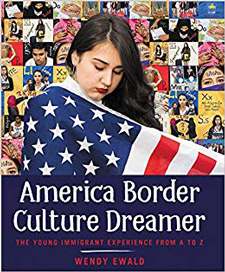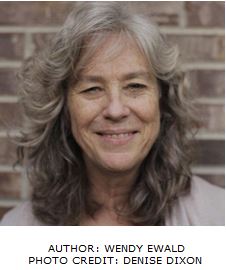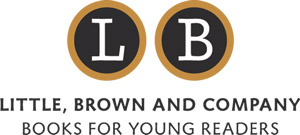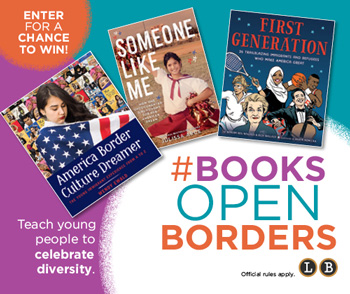#BooksOpenBorders: A Q&A with award-winning artist Wendy Ewald
Artist, author, and educator Wendy Ewald's new book America Border Culture Dreamer: The Young Immigrant Experience from A to Z gives a voice to young immigrants and first and second generation Americans. Ms. Ewald sits down with Student Library Journal.

#BooksOpenBorders: A Q&A with award-winning artist Wendy Ewald
 Artist, author, and educator Wendy Ewald's new book America Border Culture Dreamer: The Young Immigrant Experience from A to Z gives a voice to young immigrants and first and second generation Americans. Ms. Ewald sits down with School Library Journal.
Artist, author, and educator Wendy Ewald's new book America Border Culture Dreamer: The Young Immigrant Experience from A to Z gives a voice to young immigrants and first and second generation Americans. Ms. Ewald sits down with School Library Journal.
1. What inspired you to create this book?
Wendy Ewald: I was invited by Al-Bustan Seeds of Culture, a wonderful Middle Eastern organization in Philadelphia, to make a public artwork with high school students about their experiences as immigrants or refugees. I decided to make an alphabet with them. The students chose letters and words that were most reflective or descriptive of their experiences of immigration. We made photographs in the courtyard of Northeast High School to illustrate the words. The images with letters and words added became 10 by 12-feet high vinyl banners. All 26 were hung on the municipal services building downtown right across from city hall. They were up for 9 months and received a lot of attention. It was suggested that the installation would make a compelling book for teens, and I had recorded interviews with the students about their stories that I felt needed to be heard.
2. Describe what it was like to work with Al-Bustan Seeds of Culture.
Wendy Ewald: After working in Morocco and Saudi Arabia I created an installation, which was an Arabic alphabet, at the Queens Museum in New York,. Hazami Sayed, the director of Al-Bustan, saw the exhibition. She invited me to work with Al-Bustan at Northeast High School in Philadelphia, where Al-Bustan has an ongoing program. Some of the money earned from the sales of this book will support their work there.
3. You worked with 18 teenagers for this project. What were their commonalities and differences?
Wendy Ewald: The thing that was really surprising was how painful their lives have been and how difficult the transformation has been from their home countries to the U.S. I was moved by how brave and positive they were despite all that. Working with these teenagers was a chance to understand that from inside.
 4. What message do you want teachers and librarians to take away from your book? What do you want young readers to take away from this book?
4. What message do you want teachers and librarians to take away from your book? What do you want young readers to take away from this book?
Wendy Ewald: I want teachers and librarians to create a community for these young people, one where people want to know about each other and have the opportunity to be open and empathetic with each other. They know more about life than most people their age because of what they’ve had to cope with. I want people to understand what a resource they are. They should be ambassadors. The eighteen teens who were part of this project didn't know each other at the beginning, but almost right away, they became interested in learning each other’s languages. They became different people, stronger. If all young people could be that open, they'd benefit enormously.
5. How did you choose the teenagers to participate?
Wendy Ewald: I told the school that it was important that there was a spectrum of kids and the school found the students. Each participant had to explain why they wanted to participate in the project.
6. How did this work differ from the work you've done in the past?
Wendy Ewald: It differed for me because we were on the cusp of something happening and to produce something that was timely. That's exciting because it feels important.
7. What was the most surprising thing you learned from the project?
Wendy Ewald: How strong and creative these kids were. They were very shy in the beginning. Some had just come to the US, but as soon as they were given the chance to have their stories recorded, they had something to say—something they hadn't said before. It was a simple but it created a community with interest, love, and excitement.
8. What has proven to be most hopeful to you when working with teen immigrants?
Wendy Ewald: The energy, the creativity. I'm always blown away by young people’s creativity, but even more so with this project. They just couldn't believe that someone would listen and be interested in them.
9. Is there a particular teen story from this project that stands out to you?
Wendy Ewald: I'd record two or three interviews a day and when I'd walk out of the sound booth there'd be a new person in my head. One girl was from Iraq. They went to Syria to escape, but things there deteriorated. Her family then got asylum to come to the US, and now that girl is in college. In Iraq one evening her family was making food at home when US soldiers burst into the house with guns drawn. The women were trying to understand what was happening. For this book, the student worked on the word “Trust”. It's a picture of her with a blindfold over her face, reaching out.
10. You’re a renowned photographer and storyteller, what's next for you?
Wendy Ewald: I'm working on a film and an updated book I did in Kentucky in the 70s with young people who are now in their 50s. I worked with them when they were in elementary school and they made pictures, which were in a book that got a lot of attention. They photographed their everyday lives and their dreams and fantasies. It'll be interesting to show what it was like for them then and now. It will air on PBS as “Portraits and Dreams Revisited”.
11. What does #BooksOpenBorders mean to you and how does your book help open hearts, minds, and borders?
Wendy Ewald: It was a chance for me to produce something with these amazing immigrants and refugees who've lived through so much. They are positive and open; they taught me about this country and what it is made up of.
Enter for your chance to win a copy of AMERICA BORDER CULTURE DREAMER: The Young Immigrant Experience from A to Z. Official rules apply.
Book Details
Title: AMERICA BORDER CULTURE DREAMER: The Young Immigrant Experience from A to Z Dream
Author:Wendy Ewald
ISBN: 9780316484954
Publication Date: October 16, 2018
Price: $18.99
SPONSORED BY

RELATED
The job outlook in 2030: Librarians will be in demand
The job outlook in 2030: Librarians will be in demand
ALREADY A SUBSCRIBER? LOG IN
We are currently offering this content for free. Sign up now to activate your personal profile, where you can save articles for future viewing







Add Comment :-
Be the first reader to comment.
Comment Policy:
Comment should not be empty !!!